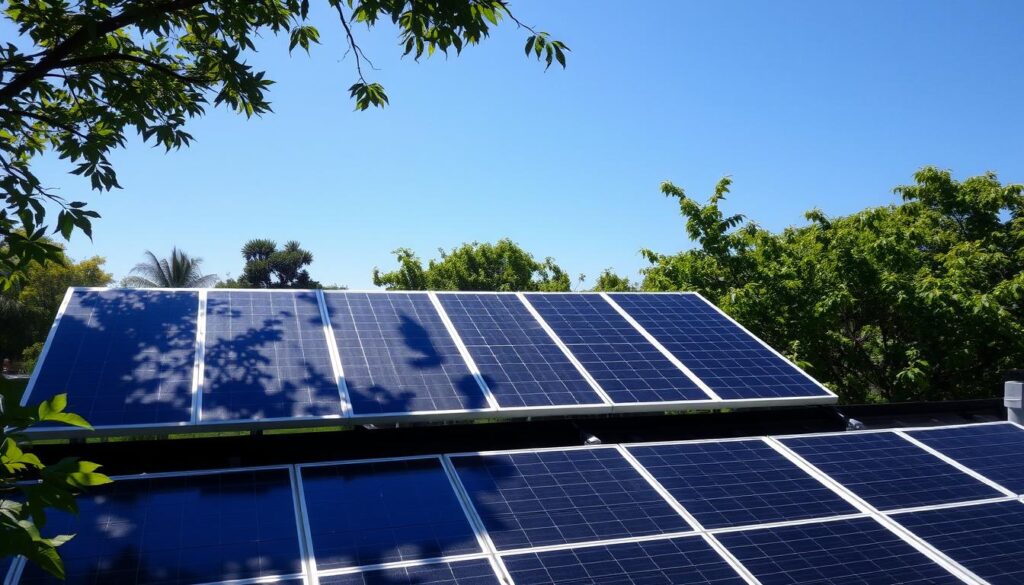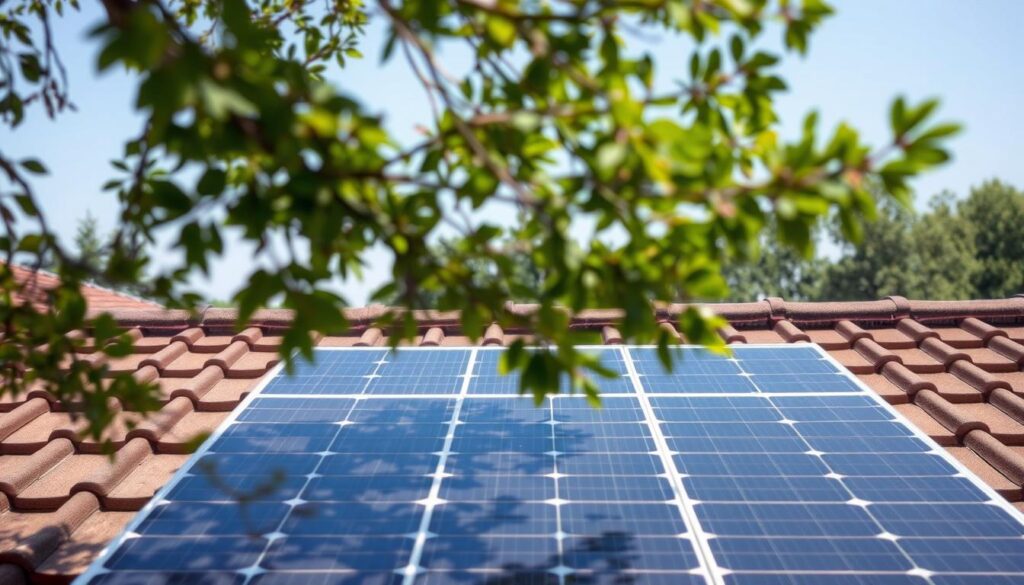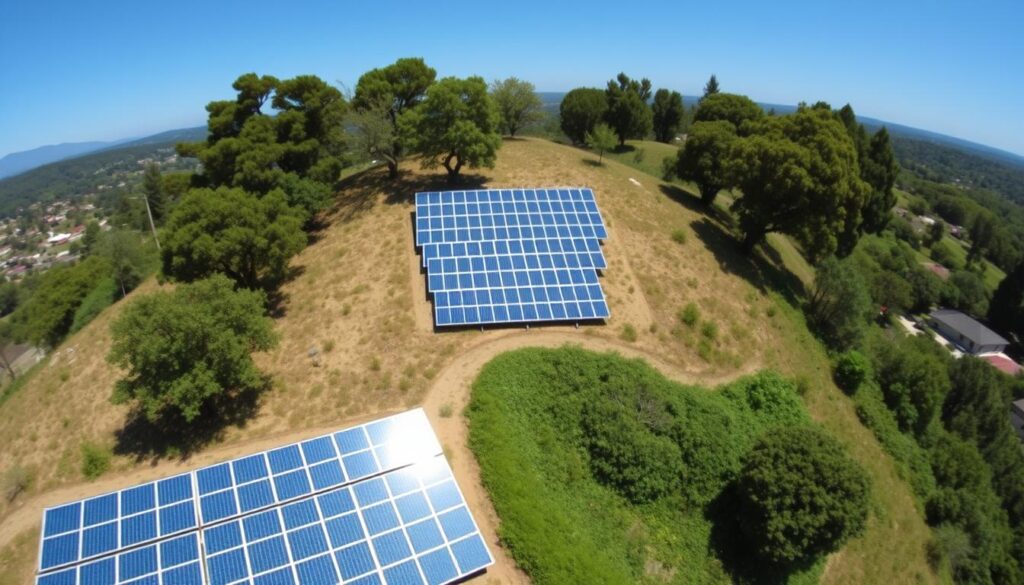The world is moving towards renewable energy, making it crucial to improve solar panel performance. Shading is a big problem for solar power systems. It can cut down energy production and affect the cost of solar installations. This guide will explore shading’s causes, its effects, and new solutions to tackle this issue.
If you’re thinking about solar power or work in the solar industry, this guide is for you. It provides key information to boost your solar PV system’s performance. By knowing about shading, its effects, and how to fix it, you can make sure your solar panels work their best. This will help you get the most out of your investment.

Key Takeaways
- Understand the different types of solar panel shading and their impact on energy production
- Explore technical solutions, such as microinverters, power optimizers, and advanced tracking systems, to minimize the effects of shading
- Learn effective maintenance and management strategies to maintain optimal solar panel performance over time
- Discover the financial implications of solar panel shading and how to maximize the return on your solar investment
- Gain insights from industry experts on the best practices for addressing solar panel shading issues
Understanding Solar Panel Shading and Its Impact on Performance
To get the most out of solar panels, it’s key to boost their efficiency. Shading is a big factor that can hurt how well solar panels work. Knowing about the different kinds of shading and how they affect panels is vital for better performance.
Types of Shading That Affect Solar Panels
There are many ways shading can hit solar panels. Things like trees or buildings can block sunlight permanently. Even shadows from passing clouds or moving objects can cause problems. Just a little shade can make a big difference, as shaded cells don’t work as well.
How Shading Reduces Energy Production
When a solar panel gets shaded, the shaded cells don’t make as much electricity. This drop in energy can be quite big. Shaded cells act like a roadblock in the panel’s electrical flow, cutting down on power. This can really cut into the savings from solar panels, making them less worth it financially.
The Financial Impact of Solar Panel Shading
The cost of shading on solar panels can be high. Less energy means less savings and a longer time to pay back the investment. In some cases, too much shade can even make solar panels not worth it. So, it’s really important to tackle shading to get the most out of solar energy.
“Minimizing solar panel shading is crucial for improving solar panel efficiency and increasing the financial benefits of solar energy investments.”
Common Sources of Solar Panel Shade and Their Effects
Optimizing solar panel output starts with knowing the common sources of solar pv system shading. Nearby buildings, tall trees, and dust can all affect your solar array. They can lower its energy production.
Tall structures like buildings or chimneys can cast shadows on panels. This blocks the sun’s rays and cuts down the system’s power.
- Placing the solar array to avoid shadows from nearby buildings helps.
- Keeping the area around the panels clean, including trimming trees, also helps.
Trees and foliage growing near panels can also cause shading. As they grow, they cast shadows on the panels. This can disrupt the system’s performance.
“Proactive monitoring and routine tree trimming are essential for maintaining optimal solar panel performance.”
Dust, dirt, and debris on panels can also reduce energy production. This type of shading is often hard to notice but can add up. Regular cleaning is key to keeping panels working well.

Knowing about these shading sources and using the right solutions can help. Solar energy fans can make sure their systems work at their best. This maximizes their investment and helps the environment.
Technical Solutions for Minimizing Shading Impact
Dealing with solar panel shading needs creative solutions. Microinverters or power optimizers are key. They help keep energy production up even when panels are shaded. These technologies boost each panel’s performance, leading to more energy from the solar system.
Microinverters vs. Power Optimizers
Microinverters and power optimizers are great for mitigating solar panel shade effects. Microinverters change DC to AC for each panel, so shading on one doesn’t hurt the whole system. Power optimizers adjust voltage and current at the panel level, making the system more efficient even with some shading.
Smart Panel Layout Strategies
Smart placement of solar panels is also vital. By thinking about where panels and shading sources like trees or buildings are, designers can set up the system to avoid shading. This way, the system’s performance is better, even with some shading.
Advanced Solar Tracking Systems
For better performance, some systems use advanced solar tracking. These systems move the panels to face the sun all day. This ensures the panels get as much sunlight as possible, reducing shading’s effect.

“By using these technical solutions, solar system owners and installers can greatly mitigate shading effects and boost energy production from their solar panels.”
Maintenance and Ongoing Shade Management
To keep your solar panels working well, you need to take care of them and manage shade. Regularly trimming trees and controlling plants is key. This helps keep sunlight from being blocked and keeps your energy production steady.
Regular Tree Trimming and Vegetation Control
It’s important to prune trees and plants around your solar panels to avoid shading. Watch how they grow and trim them when needed. This simple step can really boost your solar system’s performance.
Monitoring System Performance
Keeping an eye on your solar panel system’s performance is vital. Use monitoring tools to spot any drops in energy output. This way, you can find and fix shading problems quickly. It helps keep your solar energy running smoothly.
Seasonal Adjustment Strategies
Solar panel performance changes with the seasons. Adjusting your system for each season can help. Try changing the tilt or direction of your panels to catch more sunlight. This way, you can get the most energy all year, even with some shading.
FAQ
What are the main types of shading that can affect solar panels?
Shading can come from permanent things like buildings or trees. It can also come from temporary shadows, like clouds or moving objects. Partial shading happens when only part of the panel is blocked.
How does shading reduce energy production from solar panels?
Even a little shading can cut down solar panel energy a lot. This is because shaded cells make less current. This lowers the panel’s total power.
What is the financial impact of solar panel shading?
Shading can make solar panels work less, which means less energy. This can hurt your investment’s return. It’s key to check for shading to get the most from your solar system.
What are some common sources of solar panel shading?
Shading can come from buildings, trees, chimneys, power lines, and even dust. It’s important to think about these when setting up your solar panels.
How can microinverters and power optimizers help mitigate the impact of shading?
Microinverters and power optimizers can help with shading. They make each panel work better, even when it’s shaded. This keeps the system’s energy production up.
What are some smart panel layout strategies for avoiding shading issues?
Plan carefully to avoid shading. Think about the panels’ orientation and tilt. Also, place them away from things that might block sunlight. Tools for shading analysis can help find the best layout.
How can advanced solar tracking systems improve performance in shaded conditions?
Solar tracking systems adjust panels to follow the sun. This boosts energy production, especially in changing light conditions. It makes sure panels get as much sunlight as possible.
What are some best practices for ongoing solar panel shade management?
Good shade management means regular upkeep. Trim trees and watch your system’s performance. Adjust panel angles seasonally to keep energy production high.









